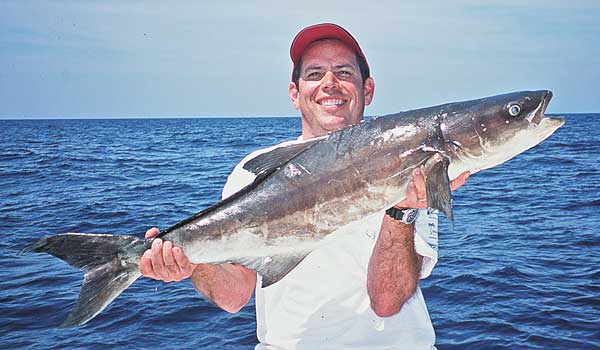
Cobia that visit the Cape Lookout and Ocracoke areas can make a fisherman’s day.
The key to catching cobia, according to Capt. Charles Brown of Davis, is patience.Usually, it’s a waiting game, and if you’ve got the patience to wait, the reward can be great.
“You might have some instant gratification with a strike, or you may have to wait all day,” said Brown, a fourth-generation guide who operates Core Banks Guide Service.
“Fishing for cobia can be like watching paint dry. You wait for hours, tending your baits, changing them out and checking for weeds on the hooks. Then all of a sudden, you get a strike and you forget all about how long you’ve been waiting for it.
“You’re waiting for that one trophy fish, and when he hits, everyone on the boat gets all excited. For most fisherman, a cobia is the biggest fish they will ever catch in their lifetimes.”
Brown once guided hunters and fishermen, but an injury has limited his ability to shoot a shotgun, so he concentrates on the nearshore waters and backwaters from Cape Lookout to Ocracoke.
And in June, that means cobia, which migrate into North Carolina’s waters in mid-May, hang around a month to six weeks, and wear out a lot of fishermen in the process.
Fish are concentrated around inlets and in deep sloughs and holes behind barrier islands. Fishing live or cut bait on the bottom is the way a majority of cobia are caught, but they also like to cruise just under the surface, making them the target of a lot of fishermen who like to sight-cast.
For example, Brown fishes deeper holes behind Shackleford Banks and around Ocracoke Inlet, but he’ll also fish around tidelines outside of inlets, paying special attention to buoys and other markers — cobia will often hold on them.
But any fishing day starts with getting bait — live menhaden in particular.
“The first thing we have to do is catch a livewell full of menhaden,” Brown said. “They’re usually schooling in the small channels or out in the sound, and the best place to find them is wherever they were yesterday.”
Finding pelicans dive-bombing the surface is a great indicator. When baitfish are present, it usually only takes Brown a couple of throws with his cast net to fill the livewell.
After a couple of passes parallel to Shackleford Banks, Brown found what he wanted on his depthfinder screen and dropped anchor.
“I’m looking for the underwater breaks and deep holes or even a slight, gradual decline in the bottom,” he said. “Cobia will congregate around any bottom change that concentrates baitfish. You drop your baits down there and wait for a bite.
Brown’s spread includes four rods that he keeps in rod holders on the gunwales. His basic fish-finder rig carries a 7/0 Mustad offset J-hook snelled to three feet of 80-pound fluorocarbon leader and an 80-pound swivel. He threads a red, plastic bead onto a 50-pound monofilament wind-on leader tied to the other end of the swivel, and above the bead, he threads on a plastic fish-finder slide. To the slide’s clip, he adds a 6- or 8-ounce surf sinker, going with the heavier weight to counteract heavier current flows. His bait is a live menhaden hooked through the nose.
“I fish with Okuma Epixor 80 spinning reels, which hold 470 yards of 20-pound Suffix mono, and Okuma Coronado reels, which hold 520 yards of 20-pound test mono. There’s a little less line on them when I’m using 25-pound mono, but it’s plenty enough line to catch a cobia.”
Waiting for cobia isn’t just a matter of changing baits and watching the wild ponies on Shackleford Banks; the long wait between cobia is often interrupted by sharks or rays. Several species of rays, some of which can top 100 pounds, arrive in the area at the same time that cobia swarm Cape Lookout. In fact, cobia often follow rays and even eat them, rolling them up like tortillas.
“A ray takes off like a cobia, especially a big ray like as a butterfly ray. But a ray won’t shake its head,” Brown said. “Once I’m sure it’s a ray, I tighten down on the drag so either the line will break or I can get the ray landed and released so I can get back to fishing for cobia.
“The drag is set at around six or eight pounds for cobia, and once the fish is hooked, I never change it during the fight. I will increase it to at least twice the amount if I’m sure it’s a ray on the hook. If you change the drag setting during the fight with a cobia, he can break the leader or line. If boats or buoys are around and the cobia wants to go around them, you follow around with the boat to keep the line off the structure because they keep the line so tight, any time the line hits something it can snap.”
On the northern end of his territory, Brown finds a lot of cobia near Ocracoke Inlet. He fishes deep holes and channels, including Wallace Channel, Blair Channel, Teaches Hole Channel, Nine Foot Channel and at Shell Castle Island.
“The water is deep and clear at Shell Castle,” Brown said. “It can be 20 feet deep, depending on the stage of the tide. The island is made of old ships’ ballast rocks, and the hole can be really deep. You can see cobia resting on the rocks on the bottom. The inlet itself is another good place to try.”
When he fishes Ocracoke, Brown starts in the inlet during the last two hours of the incoming tide, then runs inside when the tide is high to fish the deeper holes.
Another way to catch a cobia is sight-fishing. Brown said cobia often cruise on or near the surface.
“You can find cobia while you’re running down the east beach to the Cape Lookout shoals,” he said. “When I’m sight-casting, I use bucktail jigs with 8-inch Berkley Gulp! curlytails or jerk shad soft baits. I also use some of the big Storm soft baits. If I have a live menhaden, I pitch (the cobia) the live bait. A cobia can’t resist a live bait.”
Cobia are found as in singles, in pairs and in small schools consisting of several males and one larger female. Brown finds them by looking around the buoys at Beaufort Inlet and artificial-reef buoys.
The tidelines are also good,” he said. “Cobia cruise the tidelines on strong ebb tides because they are following those tides inside to get to the sound on their way to Chesapeake Bay.”
Another guide who likes to sight-fish for cobia is George Beckwith of Down East Guide Service. But he takes the sport to the extreme by using a tower on his 23-foot Parker.
“The tower gives an elevated view so you can see way down into the water,” Beckwith said. “If you get the sun behind you, you can see into the shadows of the buoys. You should check them all, because on any given day, any buoy may or may not hold cobia.”
Beckwith casts heavy jigs with soft-plastic trailers. He uses 12-inch Yum soft plastic bodies on 1- to 2-ounce jigs.
“You need something that gets down fast and still has good action,” he said. “The fish might strike the lure, and he might not. I make repeated casts until I feel like he won’t strike. Then I hit him with the lure to make him mad. Sometimes, that draws a reaction strike.”
Casts or strikes will eventually strip the trailer from the jig. They are expensive to replace, but worse is the disappointment when a cobia rips one free and swims off with it after missing the hook.
“Use a plastic zip-tie to secure the soft plastic to the jig,” Beckwith said. “Then you can fish the same lure all day.”
To clean a cobia, Brown fillets the fish, then cuts out the red meat along the lateral line.
“A cobia is so big you have to cut him into chunks,” Brown said. “I make chunks the size of bricks, then cut them again into whatever size I want to cook. It’s white meat with flavor that is unbelievable. You can grill, broil or blacken it or make stew or chowder.”

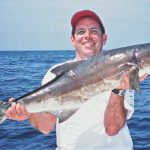
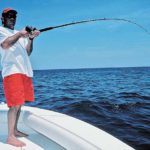
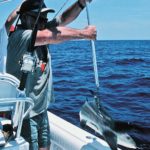
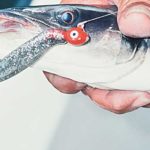
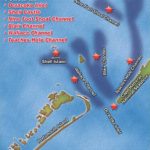
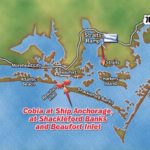




Be the first to comment